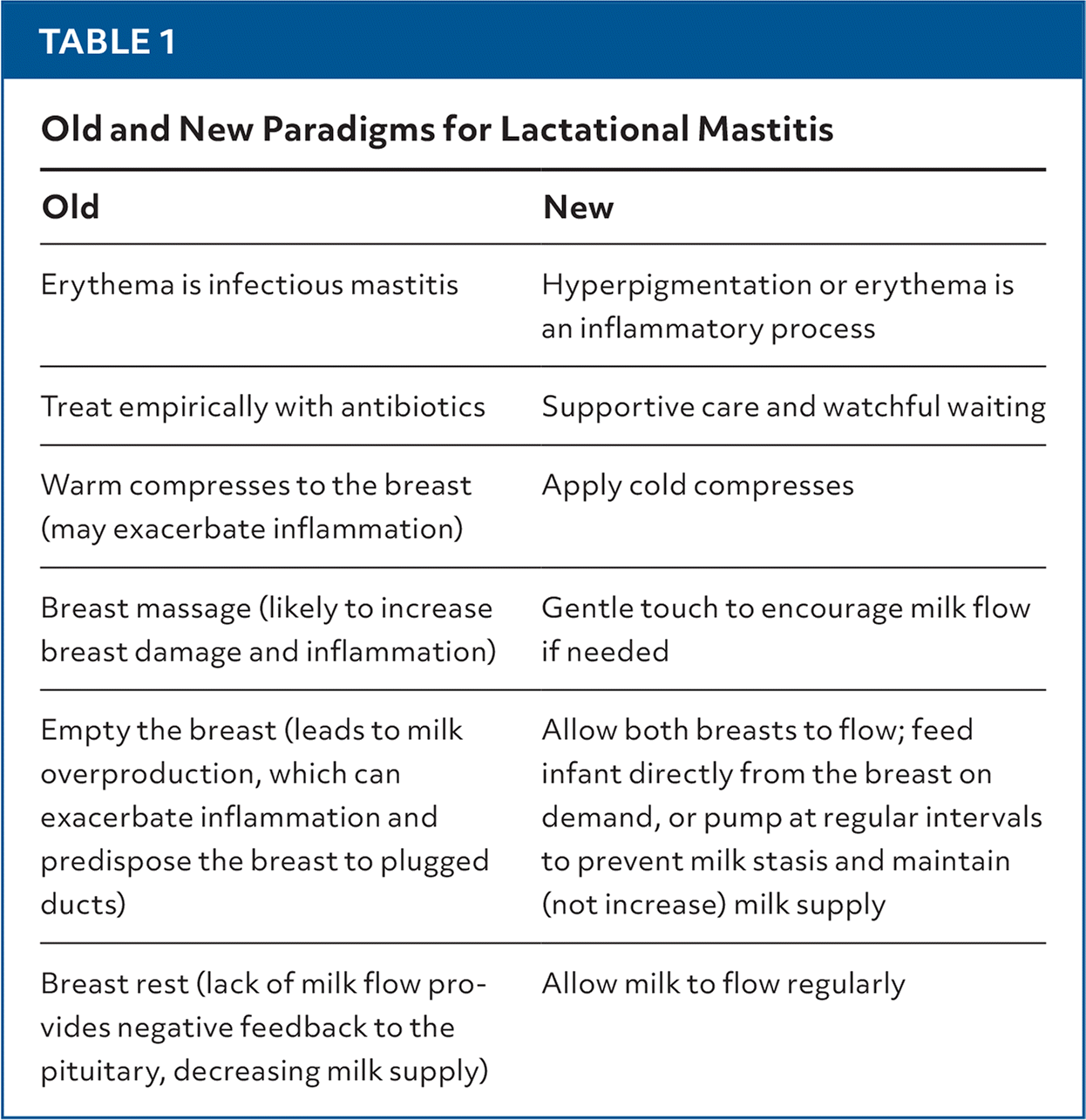
Editorials
Supporting the Paradigm Shift: Watchful Waiting for Lactational Mastitis
Am Fam Physician. 2024;110(2):118-119
Related article: Mastitis: Rapid Evidence Review
Author disclosure: No relevant financial relationships.
The mastitis review article by Morcomb and colleagues in this issue of American Family Physician1 presents us with a paradigm shift analogous to one our medical community experienced in the early 2000s for acute otitis media. When I think back to my first year of medical school, every child with an angry-appearing tympanic membrane was given an antibiotic prescription. A paradigm shift occurred in the clinical approach to acute otitis media during the next few years, with a watchful waiting approach recommended for most children, including 48 hours of rest and supportive care. The clinical condition usually improved without antibiotic intervention.2 It took time for clinical practice to catch up with the new guidelines. As a medical student and resident physician, I witnessed the differences in the implementation of the new guidelines from preceptor to preceptor. Now, watchful waiting for children older than 2 years with acute otitis media is common practice, and we wait for the electronic health record message updates or give a pocket prescription for the parent to fill if needed.3,4
The mastitis article presents readers with bestpractices based on a 2022 protocol from the Academy of Breast-feeding Medicine and clinical guidance from a mini review published in JAMA.5,6 The update is based on basic science research, small studies in lactating patients, and expert opinion from breastfeeding medicine physicians across the globe. The most recent Cochrane review on antibiotics for lactational mastitis states that there is insufficient evidence to confirm or refute the effectiveness of antibiotic therapy.7 I appreciate that this update encourages a watchful waiting approach rather than continuing to treat lactational mastitis with antibiotics based on insufficient evidence.
I have been studying and practicing breastfeeding and lactation medicine for almost 20 years, and it has been common for physicians to label any erythematous breast as mastitis and treat empirically with antibiotics. Acknowledging the complexity of making changes in our clinical practice, Table 1 outlines old and new paradigm approaches for lactational mastitis.

| Old | New |
|---|---|
| Erythema is infectious mastitis | Hyperpigmentation or erythema is an inflammatory process |
| Treat empirically with antibiotics | Supportive care and watchful waiting |
| Warm compresses to the breast (may exacerbate inflammation) | Apply cold compresses |
| Breast massage (likely to increase breast damage and inflammation) | Gentle touch to encourage milk flow if needed |
| Empty the breast (leads to milk overproduction, which can exacerbate inflammation and predispose the breast to plugged ducts) | Allow both breasts to flow; feed infant directly from the breast on demand, or pump at regular intervals to prevent milk stasis and maintain (not increase) milk supply |
| Breast rest (lack of milk flow provides negative feedback to the pituitary, decreasing milk supply) | Allow milk to flow regularly |
As our knowledge and understanding increase and we follow the best clinical expert guidance for our patients, we must shift our paradigm and appreciate that mastitis is not always an infection, but a spectrum of changes in the lactating breast that often begins with milk stasis, edema, and inflammation. Sometimes bacteria are included in the spectrum, but not always. We also need to recognize the mastitis spectrum in people with all skin types—the word erythema implies redness, which is readily apparent in patients with fair skin, but in patients with darker, more pigmented skin, the erythema of mastitis can have a dark brown, purple, or red appearance.
As the article highlights, it is important to provide anticipatory guidance to our patients before the mastitis spectrum sets in by supporting optimal lactation according to each patient’s goals. If the inflammatory process begins, the implementation of watchful waiting with lactation support, physical rest, hydration, application of cool compresses, and encouragement of a routine breast flow without over- or understimulation is recommended instead of immediately prescribing antibiotics or recommending application of heat, breast massage, extra pumping, or breast rest. It may be helpful, although not required, for patients to take a nonsteroidal anti-inflammatory drug in adult-appropriate dosages for 2 to 3 days as needed. If symptoms do not improve in 24 to 48 hours or are worsening, antibiotics can be used based on clinical judgment. All postpartum patients should be screened for depression, especially those with inflammation in the mastitis spectrum. The mind-body connection and inflammation associated with postpartum mood disorders are being studied, described, and further considered in medical literature.8
Watchful waiting in the setting of the lactational mastitis spectrum avoids antibiotic resistance, reduces the predisposition to thrush or yeast issues in the lactational dyad, and more optimally supports the microbiome of the infant and lactating patient.9–11 Because we have traversed a similar paradigm shift in many of our medical memories, I am hopeful that this newest paradigm shift to watchful waiting for the lactational mastitis spectrum will take off right away.
Editor’s Note: Dr. Lawrence is chair of the American Academy of Family Physicians’ Breastfeeding Medicine Member Interest Group.

